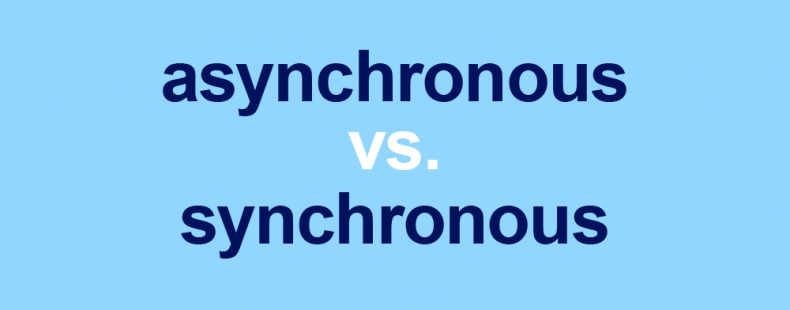The words synchronous and asynchronous have become part of our lives, especially when it comes to the forms of synchronous and asynchronous learning and working that have been accelerated by the COVID-19 pandemic.
The terms are also used in other contexts, including in digital technology and in general, such as to differentiate forms of communication that happen in real time from those that don’t.
We’ll break down the difference and explain what synchronous and asynchronous learning often look like in practical terms.
⚡ Quick summary
Synchronous means happening at the same time. Asynchronous is the opposite—not happening at the same time. Synchronous learning involves students interacting with a teacher in real time, while asynchronous learning involves students working outside of a classroom setting and at their own pace.
What does synchronous mean?
Synchronous is an adjective that’s defined as “occurring at the same time; coinciding in time; contemporaneous; simultaneous.”
In general, synchronous is used to describe things that happen at the same time. Synchronous communication involves real-time back-and-forth—talking face to face and video chatting are synchronous forms of communication. Synonyms for synchronous include coincident, contemporaneous, simultaneous, and synchronized.
In education, synchronous has evolved to mean “occurring in real time, as with participants logged in at an appointed time for a live lecture or discussion” (such as over a live video platform). In the context of virtual learning, synchronous learning occurs in real time—meaning that the student and teacher are in the same virtual setting at the same time, typically through a two-way video platform.
In the context of computers and digital technology, the word synchronous typically implies that functions are performed in set intervals or with a time sequence.
What does asynchronous mean?
Asynchronous is an adjective that means “not occurring at the same time.”
In general, asynchronous is used to describe things that don’t happen in parallel. Asynchronous communication, for example, involves messages being transmitted back and forth but not through direct interaction and not necessarily at the same time. Examples include email and message boards. Texting, though often immediate, is typically considered asynchronous because it does not necessarily need to happen in sync. Synonyms for asynchronous include nonsynchronous and (the much less common) allochronic.
In education, asynchronous has come to mean “occurring or able to be completed independently according to a person’s own self-paced schedule or within a broad window of time, but not coordinated to be completed in real time with another participant.”
A student completing assignments on their own, outside of a classroom or video call, is an example of asynchronous learning.
Asynchronous has a more specific sense in digital technology, in which it means “having each operation started only after the preceding operation is completed.”
Synchronous vs. asynchronous learning
Traditional schooling is largely synchronous, with students engaging in synchronous learning in classrooms in brick-and-mortar buildings. Virtual classrooms—such as those conducted via two-way video technology, often recreate this synchronous experience with a teacher instructing a “room” of students in real time, with the ability for the teacher to ask questions and for the students to respond.
In an asynchronous course, a student does not need to meet in real time with a live class or teacher. Instead of the constraints of a traditional classroom, students participating in asynchronous learning can move through assignments at their own speed and are often aided by online discussion boards and emails.
Many virtual learning environments incorporate a mix of synchronous and asynchronous learning, in which students spend some time in a live virtual classroom and then go off to complete assignments on their own.
Where do the words synchronous and asynchronous come from?
Synchronous uses the Greek syn-, meaning “together.” The middle part of the word comes from the Greek chron(os), meaning “time.” The ending -ous is used to form adjectives. Based on its word parts, synchronous basically means “happening at the same time.” Asynchronous uses the prefix a-, meaning “not,” making it the opposite: “not happening at the same time.”
How to use synchronous vs. asynchronous
Things that happen together and at the same time are synchronous. Asynchronous is the opposite—it describes things that happen at staggered times or not together in real time.
In the context of education, synchronous learning involves learning together in real time—a direct back-and-forth between teacher and students. Asynchronous learning involves students working on their own and at their own pace outside of a traditional classroom or video classroom setting.
In the context of communication, talking to someone in person, over the phone, or over video chat are all considered synchronous because they happen together and at the same time. Email, on the other hand, is an asynchronous form of communication.
Examples of synchronous and asynchronous used in a sentence
Here are some examples of the kinds of sentences where you might encounter synchronous and asynchronous.
- Since Camila’s school was participating in synchronous learning, she had to log on at the exact same time as the rest of her class.
- The teacher provided the students with prerecorded videos for their asynchronous assignments, which they were asked to complete on their own.
- The online discussion board allowed the conference participants to conduct asynchronous conversations after attending their sessions.
- When the team began working from home exclusively, employees relied on asynchronous communication tools, like email and project management tools.
- Some online classes include a combination of synchronous and asynchronous learning to allow students to work on their own while also getting a classroom experience.














